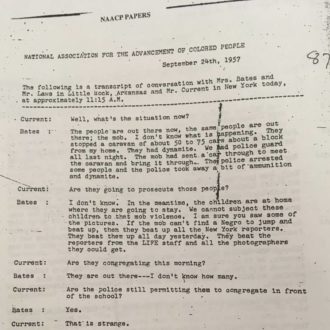
After much consideration, I have settled on concentrating in the History Department. Consequently, this semester finds me taking several courses with a historical bent. Thus far in these classes, I have been immersed in the theory and practice of historical research. Today, I’d like to share some of the highlights from my experiences in History 280: Approaches to American History.
HIS 280 is a rather unique class. The course consists of only one 50-minute lecture per week and two 50-minute seminars, as opposed to the traditional format of two 50-minutes lectures and one 50-minute precept. Moreover, the readings consist entirely of three (rather dense) Pequod packets chock full of primary sources from three seminal periods in the history of the United States: The School Integration Crisis in Little Rock, Arkansas of 1957-58; changes in the Federal Government’s Native American policies in the 1920s; and the Salem Witch Trials of 1692-193. Given only primary documents from these time periods, it is the students’ job to come up with a synthetic, narrative account of what took place—to produce history.
Currently, we’re in the midst of unpacking documents related to the incredibly brave–in ways I am only beginning to more fully understand–‘Little Rock Nine,’ the first African-American teenagers who entered into and thus integrated Central High School in September 1957. Thankfully, there are many documents chronicling this important event. The flipside to this, however, is that there is a lot of raw data to work through: from census records, to newspaper articles, telephone transcripts, and memoirs recounting the events of that fateful year. The difficulty for the budding historian thus becomes identifying pieces of critical information buried in the mass of assigned documents.
To do this, one must first engage in a critical close reading of the documents. Skimming for themes and broad narrative arcs will not suffice; this would only yield the same general story of the Little Rock Nine that many of us have already heard. So, attention to detail is critical—as is redefining what details to pay attention to. I learned this firsthand when looking at the Supreme Court’s decision in Brown v. Board of Education, republished in a journal called the Race Relations Law Reporter.
At first, that latter detail—the journal title—seemed of little consequence to me, so I didn’t investigate it further. Surely the case itself was more important, or so I thought. In class, however, our professor pointed out that this was Volume One, Issue One of this journal. That there was a new legal journal dedicated to race created in the immediate aftermath of Brown v. Board is a rich detail that offers telling insight into the magnitude of the decision, as well as its reception. Yet, this detail is easily overlooked unless one is consciously keeping track of such things.
Beyond reading documents closely, the historical researcher should step back and consider the type of document that they’re working with, as well. A Supreme Court decision requires of its reader a different mindset than, say, a telephone transcript. For one thing, legal arguments are intended for a wider audience and are meticulously prepared well in advance of their release, while telephone calls are more personal and impromptu. These differences are significant, so I suggest a specialized approach to each category of document. To demonstrate this, I’ll share some thoughts on approaching telephone transcripts.
Conversations exist to facilitate exchanges of information, so looking at transcripts has the face value of revealing important facts about the lives of those conversing. But conversations are not unidimensional essays, and they have more to offer than their informational utility. So, I try to read a transcript like an actor would read lines for a play. That is, I aim to read transcripts conversationally, in an attempt to glean the tone, attitude, and general disposition of the speaker. In this way, I, the researcher, (ideally) gain a better understanding of who this real, complex person was—and thus, what motivated them, what made them tick, etc. Animating characters not only helps me to understand them, but also serves to vivify even seemingly mundane information. For instance, I can attempt to understand how systematic inequalities revealed in say, census data, would have felt to different figures in 1957 Little Rock, Arkansas.
These are just a few initial reflections on the process of creating history from primary documents. Such a process is necessarily immersive, so if you find yourself in a project such as this, my best advice is: don’t just lean in–dive deep; intense research effort is essential, but cannot replace strategies that give your research new depth. Acknowledging this will help you produce a solid academic project, and, perhaps more uniquely, give you a strange (but really cool) sense of connection to admirable figures from the past.
— Shanon FitzGerald, Social Sciences Correspondent

